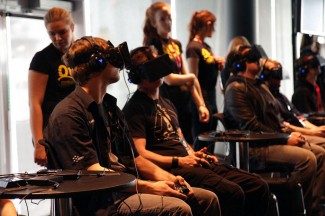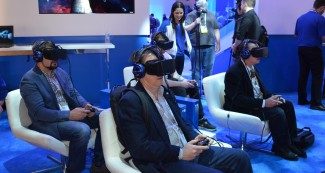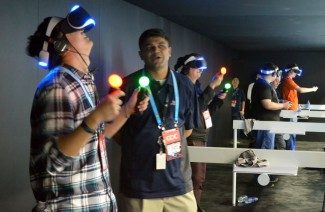5. Hygiene (Cleaning)
 The hygiene issue is broken down into three areas—the ‘wet’ (sweat, oils and makeup/hair products), the ‘dry’ (skin, scalp, and hair), and the ‘unusual’ (lice/eggs, earwax and others!). Away from these physical representations of detritus there is the issue of VR headset as a medium of bacterial transmission, which will need more than a quick wipe-over to get rid of. The ‘bacterial’ issues are not unusual for public-space items that are evasive—the 3D cinema industry has worked long and hard to address these hygiene issues, especially as their 3D glasses are in the (usually sticky) hands of very young viewers. Along with dish-washer style systems for large 3D cinema installations there is a less invasive ultraviolet light sterilization process.
The hygiene issue is broken down into three areas—the ‘wet’ (sweat, oils and makeup/hair products), the ‘dry’ (skin, scalp, and hair), and the ‘unusual’ (lice/eggs, earwax and others!). Away from these physical representations of detritus there is the issue of VR headset as a medium of bacterial transmission, which will need more than a quick wipe-over to get rid of. The ‘bacterial’ issues are not unusual for public-space items that are evasive—the 3D cinema industry has worked long and hard to address these hygiene issues, especially as their 3D glasses are in the (usually sticky) hands of very young viewers. Along with dish-washer style systems for large 3D cinema installations there is a less invasive ultraviolet light sterilization process.
From previous experience developing and operating one of the first mass-audience VR entertainment system at Walt Disney Imagineering, the team that originated the Disney ‘GatorVision’ in 1995 undertook an exhaustive process to ascertain the best way to operate a VR headset for a wide age and anthropometric scale of users, and also to create something that could be easily cleaned and processed. From the 1995/1996 study into VR as an attraction, this data was expanded upon to create the updated ‘DisneyVision’ VR headset and the creation of the infamous DisneyQuest VR Operation Manual which charted the benchmark ‘do’s and don’t’s’ of operating VR in an attraction environment. Seen as the Bible on this subject, details of this manual are shrouded in secrecy, information from which is still closely guarded by those involved in its creation—especially as these highly successful VR attractions are still in operation to this day having served thousands of guests.
The final version of the ‘DisneyVision’ VR headset came as a two part system with a head liner that directly contacted with the user’s head, and the main display and audio system that connected to the weight relief mechanism. The liner unit was treated like any 3D glasses at a cinema and cleaned en mass via a liquid process. This was a system specially created for mass-audience utilization, but the VR units are currently used today are development kits at best, and prototypes at worst—in many cases hand-built and as durable as a chicken egg. Particular attention needs to be paid towards any deterioration during their usage.
 The need of wiping down the VR headset is a tricky issue. The need to avoid abrasive cloths and solvent prove to be a key issue—the baby wipes (‘wet wipe’) are seen as the savior of the mass VR headset operation, though it is important to ensure that the wipes purchased do not contain alcohol, solvents, or surfactant. The needs of the users who may be allergic, as well as the damage to the actual VR headset components, need to be considered (interactions between some solvents and the dev-kit plastics and lenses are a concern). One other word of advice is also do not use unsuitable cleaning products. Recently a window cleaning product was seen to be used to clean down a lens with the operator ignoring the issue that the liquid in question stated clearly “May cause skin irritation.”
The need of wiping down the VR headset is a tricky issue. The need to avoid abrasive cloths and solvent prove to be a key issue—the baby wipes (‘wet wipe’) are seen as the savior of the mass VR headset operation, though it is important to ensure that the wipes purchased do not contain alcohol, solvents, or surfactant. The needs of the users who may be allergic, as well as the damage to the actual VR headset components, need to be considered (interactions between some solvents and the dev-kit plastics and lenses are a concern). One other word of advice is also do not use unsuitable cleaning products. Recently a window cleaning product was seen to be used to clean down a lens with the operator ignoring the issue that the liquid in question stated clearly “May cause skin irritation.”
How much cleaning during each demonstration is in the hands of the operator and will have to be part of the briefing they are given. Obviously after the end of each demo the operator needs to look at the VR headset to ensure that they are still working properly, but also to ensure there are no hygiene issues that need a wipe-down.
Finally, regarding the Oculus Rift DK1 and DK2 (as well as some other VR headsets), the issue of how to clean the sponge face-liner and the cloth strap to the head has been raised. At present there is no simple answer—again referring to the earlier comment, these are prototypes or developer kits. But at least some effort should be kept on checking their quality and ensuring the best cleaning that can be done. After the event a need to partially disassemble the units and clean with compressed air and cotton swabs is advised, depending on the number of demos expected.
6. Disorientation (Cool Down)
During the ‘unloading process’ it is important that the operators are made aware to keep a special eye open for disorientation or other issues exhibited by the user – as well as being advised that it is better to have the user start the removal process than yanking the headphone and VR headset off the user. Regarding a longer duration of demonstration, the instances ‘sim-sickness’ is likely to increase—though as stated, most demonstrations to audiences should be kept short and simple. However it is easy to spot symptoms of an individual experiencing difficulty with the VR experience which can be broken down into:
- Voiced disquiet
- Aborting the VR experience
- Exhibiting disorientation
- Complaining of headache
It is a good idea to have an extra seat, off to one side, for individuals that feel disorientated to briefly rest at and get them out of the unloading area while they regain their composure (known as the ‘cool-down’ period).
The final concern (and very rare occurrence) is actual sim-sickness (a ‘protein spill’ as some of us call it in the theme park business). A little trick about dealing with protein spill can be borrowed from the parks industry, which it borrowed from the airline industry and in particular PanAm Airways (showing my age). If someone is ill, then there is a danger that the smell of this will cause others to also be ill (a natural human response); to negate this simply ensure you have some instant coffee sachets on hand, empty them and the smell will be counteracted allowing you to deal with the situation and clean up. The coffee’s overpowering smell deactivates the situation.
Regarding situations while setting up the demonstration before the doors open at the venue you are at, establish some situational awareness. Find out who is the head organizer or person-in-charge, ascertaining fire alarm policy for the venue. Also confirm you have a link to the organizers so that when it comes time to end the event you could use some help in closing off the queue-line and advising those in the queue that the event is coming to an end. Simple issues, but we want to ensure everyone has a good experience rather than being disappointed waiting in line for hours only to be told “you can’t ride!”







